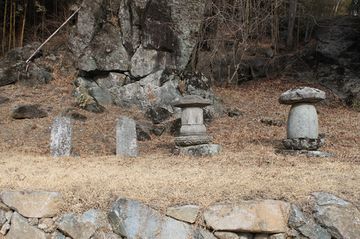"함양 안국암 승탑"의 두 판 사이의 차이
(→영문) |
|||
| (사용자 2명의 중간 판 4개는 보이지 않습니다) | |||
| 1번째 줄: | 1번째 줄: | ||
| − | |||
{{문화유산정보 | {{문화유산정보 | ||
|사진=함양안국암승탑.jpg | |사진=함양안국암승탑.jpg | ||
| 32번째 줄: | 31번째 줄: | ||
A stupa is a structure built to enshrine the relics or cremated remains of a Buddhist monk. When a renowned monk passes away, his disciples and followers build a stupa and a stele to commemorate him. The stele records the deceased monk’s life and achievements. | A stupa is a structure built to enshrine the relics or cremated remains of a Buddhist monk. When a renowned monk passes away, his disciples and followers build a stupa and a stele to commemorate him. The stele records the deceased monk’s life and achievements. | ||
| − | There are a total of four stupas at | + | There are a total of four stupas at Angugam Hermitage. Two of them contain the relics and cremated remains of the monk Haengho, who lived during the early period of the Joseon dynasty (1391-1910). The other two stupas contain the relics of monks Geumsongdang and Seosang. Among these, the octagonal stupa of the monk Haengho is designated as a cultural heritage. |
| − | + | Haengho was trusted by Kings Taejong (r. 1400-1418) and Sejong (r. 1418-1450). He was especially respected by King Sejong’s older brother, Prince Hyoryeong (1396-1486), who referred to him as a “true buddha.” Haengho was known for having travelled to the various temples in the Jirisan Mountain area and renovating those which had fallen into disrepair. | |
| − | |||
===영문 해설 내용=== | ===영문 해설 내용=== | ||
승탑은 스님의 사리나 유골을 모셔 놓은 일종의 무덤이다. 덕망 높은 스님이 입적하고 나면 제자와 신도들이 스님을 기려 승탑과 탑비를 세웠으며, 탑비에는 스님의 행적을 기록하였다. | 승탑은 스님의 사리나 유골을 모셔 놓은 일종의 무덤이다. 덕망 높은 스님이 입적하고 나면 제자와 신도들이 스님을 기려 승탑과 탑비를 세웠으며, 탑비에는 스님의 행적을 기록하였다. | ||
| − | 안국암에는 4기의 승탑이 있는데, 2기는 조선 초의 승려인 행호조사의 사리와 유골을 모셨고, 다른 2기는 각각 금송당과 서상대사의 사리를 모셨다고 전해진다. 4기의 승탑 중 가운데에 있는 팔각형의 행호조사 승탑이 문화재로 지정되어 있다. | + | 안국암에는 4기의 승탑이 있는데, 2기는 조선 초의 승려인 행호조사의 사리와 유골을 모셨고, 다른 2기는 각각 금송당과 서상대사의 사리를 모셨다고 전해진다. 4기의 승탑 중 가운데에 있는 팔각형의 행호조사 승탑이 문화재로 지정되어 있다. |
| − | 행호조사는 조선 태종(재위 1400-1418)과 세종(재위 1418-1450)의 신임을 얻었으며, | + | 행호조사는 조선 태종(재위 1400-1418)과 세종(재위 1418-1450)의 신임을 얻었으며, 특히 세종의 형 효령대군(1396-1486)은 행호를 특히 공경하여 그를 ‘진불(眞佛)’이라 불렀다고 한다. 행호는 지리산 부근의 여러 사찰을 다니면서 전란으로 쇠락해진 사찰들을 재건하는 데 힘을 기울였다. |
=='''참고자료'''== | =='''참고자료'''== | ||
| 54번째 줄: | 52번째 줄: | ||
[[분류:승탑]] | [[분류:승탑]] | ||
[[분류:2020 영문집필]] | [[분류:2020 영문집필]] | ||
| + | [[분류: 2020 국문집필]] [[분류: 2020 국문초안지원사업]] | ||
2021년 2월 5일 (금) 16:34 기준 최신판
| 함양 안국암 승탑 Stupa of Angugam Hermitage, Hamyang |
|
 함양 안국암 승탑, 국가문화유산포털, 문화재청. |
|
| 대표명칭 | 함양 안국암 승탑 |
|---|---|
| 영문명칭 | Stupa of Angugam Hermitage, Hamyang |
| 한자 | 咸陽 安國庵 僧塔 |
| 주소 | 경상남도 함양군 마천면 천왕봉로 1035-337 (가흥리) |
| 국가유산 종목 | 경상남도 유형문화재 제35호 |
| 지정(등록)일 | 1972년 2월 12일 |
| 분류 | 유적건조물/종교신앙/불교/탑 |
| 수량/면적 | 1기 |
| 웹사이트 | 함양 안국암 승탑, 국가문화유산포털, 문화재청. |
|
|
|
해설문
국문
안국사 경내에는 4기의 부도(浮屠, 스님의 사리를 안치한 탑)가 있는데, 2기는 행호조사(行乎祖師)의 사리와 유골을 봉안한 것이고 다른 2기는 금송당(禁松堂)과 서상대사(西上大師)의 사리를 봉안한 것이라 전해진다. 4기 중 문화재로 지정된 것은 기단(基壇, 건축물의 터를 다듬은 다음 터보다 한 층 높게 쌓은 단)에서부터 지붕돌에 이르기까지 모두 8각의 평면을 기본으로 삼고 있는 승탑이다.
이 승탑은 통일신라 시대 8각 부도의 형태를 계승한 고려 시대의 것으로, 비교적 안정감이 있고 단정한 형태로 소박한 느낌을 준다.
영문
Stupa of Angugam Hermitage, Hamyang
A stupa is a structure built to enshrine the relics or cremated remains of a Buddhist monk. When a renowned monk passes away, his disciples and followers build a stupa and a stele to commemorate him. The stele records the deceased monk’s life and achievements.
There are a total of four stupas at Angugam Hermitage. Two of them contain the relics and cremated remains of the monk Haengho, who lived during the early period of the Joseon dynasty (1391-1910). The other two stupas contain the relics of monks Geumsongdang and Seosang. Among these, the octagonal stupa of the monk Haengho is designated as a cultural heritage.
Haengho was trusted by Kings Taejong (r. 1400-1418) and Sejong (r. 1418-1450). He was especially respected by King Sejong’s older brother, Prince Hyoryeong (1396-1486), who referred to him as a “true buddha.” Haengho was known for having travelled to the various temples in the Jirisan Mountain area and renovating those which had fallen into disrepair.
영문 해설 내용
승탑은 스님의 사리나 유골을 모셔 놓은 일종의 무덤이다. 덕망 높은 스님이 입적하고 나면 제자와 신도들이 스님을 기려 승탑과 탑비를 세웠으며, 탑비에는 스님의 행적을 기록하였다.
안국암에는 4기의 승탑이 있는데, 2기는 조선 초의 승려인 행호조사의 사리와 유골을 모셨고, 다른 2기는 각각 금송당과 서상대사의 사리를 모셨다고 전해진다. 4기의 승탑 중 가운데에 있는 팔각형의 행호조사 승탑이 문화재로 지정되어 있다.
행호조사는 조선 태종(재위 1400-1418)과 세종(재위 1418-1450)의 신임을 얻었으며, 특히 세종의 형 효령대군(1396-1486)은 행호를 특히 공경하여 그를 ‘진불(眞佛)’이라 불렀다고 한다. 행호는 지리산 부근의 여러 사찰을 다니면서 전란으로 쇠락해진 사찰들을 재건하는 데 힘을 기울였다.
참고자료
- 함양 안국암 승탑, 국가문화유산포털, 문화재청. http://www.heritage.go.kr/heri/cul/culSelectDetail.do?ccbaCpno=2113800350000
- 행호대선사, 금강신문, 2011.12.02. http://www.ggbn.co.kr/news/articleView.html?idxno=19324
- 함양 안국암 승탑, 디지털함양문화대전. http://hamyang.grandculture.net/hamyang/toc/GC07200469